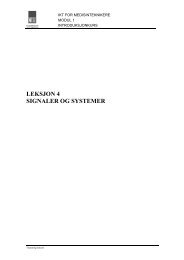The Online World resources handbook
The Online World resources handbook
The Online World resources handbook
Create successful ePaper yourself
Turn your PDF publications into a flip-book with our unique Google optimized e-Paper software.
Getting started http://home.eunet.no/~presno/bok/v2.html<br />
Adapters to set them apart from traditional modem technology, but from the users'<br />
perspective, modems they are.<br />
<strong>The</strong> recipient of data also needs a modem. In his case, the sound codes will have to<br />
be translated back into their original form as digital codes. When this is done, he can<br />
view text and pictures on the screen, and use the received data in other applications.<br />
You can buy modems on an expansion card for installation in your computer, or in<br />
a separate box. Often, a modem has already been built into the computer, when you buy<br />
it.<br />
Whether to buy an internal or an external modem is a question of needs:<br />
A portable computer with an internal modem is easier to bring on travels than an<br />
external modem with a modem cable and a power adapter.<br />
An external modem can serve several computers. Some of them are so compact<br />
that they fit besides your toothbrush in the toilet bag.<br />
An internal modem blocks one of your serial ports.<br />
External modems<br />
<strong>The</strong> options are many. <strong>The</strong> modems differ on speed, features, prices and whether they<br />
DUH DSSURYHG IRU XVDJH LQ \RXU FRXQWU\<br />
Some of them are connected to the phone line by cable. Others are connected to<br />
the handset (to the talk and listen part) by two rubber cups. We call such modems<br />
acoustic modems (or acoustic couplers).<br />
Acoustic modems are useful where connecting other modems to the telephone is<br />
difficult. <strong>The</strong> bad news is that you'll get more noise on the line. Acoustic modems can<br />
therefore not be recommended for use in other cases.<br />
Asynchronous or synchronous modems?<br />
Formerly, data communication was done by sending job commands to a mainframe<br />
computer, and having the result returned in one batch. <strong>The</strong> modems were called<br />
synchronous. Such modems (and computers) are still in use in some large corporations.<br />
Most of today's online services are based on an interactive dialog between the user<br />
and the remote computer. <strong>The</strong> user enters a command, for example a letter or a number<br />
in a menu, and the result is returned almost immediately. <strong>The</strong> modems used for such<br />
work are called asynchronous (See "Explanation of some words and terms" in Appendix<br />
4).<br />
Unless you know that you must have a synchronous modem, buy an asynchronous<br />
one.<br />
Choice of speed<br />
Speed is measured in many ways. One method is to use baud. Another is to use<br />
characters per second (cps) or bits per second (bps).<br />
Bps is a measure of how many data bits that can be transferred over a data channel<br />
in one second. (Each byte is split up into bits before transfer during serial<br />
communication.)<br />
<strong>The</strong> relationship between baud and bits per second is complex, and often misused.<br />
Bits per second is unambiguous. In this book, we will use it as bps.<br />
We can estimate the number of characters per second by dividing the number of<br />
bps by ten. For example. 1200 bps is roughly 120 cps.<br />
In 1987, 300, 1200 and 2400 bps asynchronous modems were the standard in many<br />
countries. Around 1990, the growth in 9600 bps modems and modem with faster speeds<br />
gained momentum. Today, 28000 bps modems are very popular.<br />
Modem user manuals often give transfer speed by referring to some international<br />
classification codes. Here are some ITU TSS codes with explanation:<br />
V.21 0 300 bps<br />
full duplex<br />
Still used by a small group. Cannot<br />
communicate with the American Bell<br />
2 of 9 23.11.2009 15:50

















